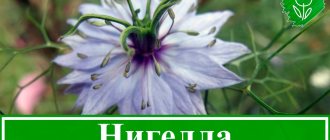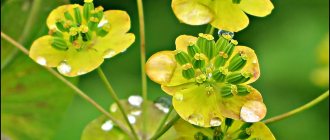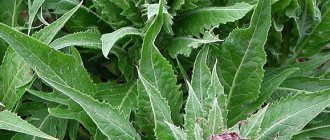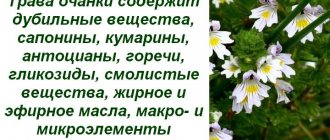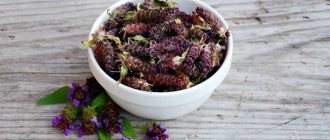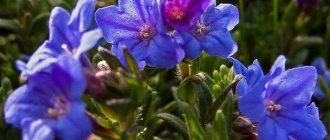Photo and description of the plant
Blueberry is a herbaceous perennial with a wide habitat. You can find the plant in the Eastern and Western Siberian districts, in the Asian steppes and the Caucasus mountains. The cyanosis prefers moist soils, so it settles in floodplains, water meadows, and near natural reservoirs. It also grows in clearings or forest edges in wooded areas.
Most often these are low bushes of ribbed stems covered with complex odd-pinnate leaves consisting of lanceolate leaflets. But it happens that the plant reaches more than a meter in height.
At the beginning of summer, the cyanosis is covered with panicles of blue or purple bell-shaped flowers with a light center. Flowering continues until the end of August, when boxes with black angular seeds form in place of the bells.
Of greatest interest is the fleshy, medium-sized rhizome of the plant, overgrown with thin root shoots. It is the root of cyanosis that contains a large amount of useful substances, thanks to which the plant is considered the best remedy for the treatment of nervous disorders and respiratory diseases.
Description of the plant
Blue cyanosis is a perennial herb of the cyanaceae family. Its thick root is short in length - 5 cm. In the first year of growth it forms basal leaves, and in subsequent years - stems. Young representatives have single stems, while other plants have more stems. The erect stem may branch slightly at the top.
Also take a look at the article about the medicinal properties of cloudberries.
Reaching one and a half meters in height, it has a hollow structure. It contains odd-pinnate smooth leaves. Their location is the same. The lower ones have petioles, and the upper ones are slightly pointed. At the end of the stem are blue inflorescences consisting of flowers with a five-part calyx.
Flowering occurs in early summer of the second year. After this, a fruit is formed, which is a tricuspid capsule with a large number of narrow-winged seeds.
Blueberry can be found in Europe, western and eastern Siberia. She loves moist soil with a high content of humus. The plant is common on the edges of rivers, forest edges, clearings and in dense thickets.
Procurement of raw materials
The most valuable substances are found in the roots of young plants. They start collecting them in August-September. The roots are located close to the surface of the earth, so they can be easily removed by hand. Having rid the future raw material of lumps of soil, it is separated from the stem, washed and placed in a dark, well-ventilated place.
If you leave the plant in direct sunlight, it will lose its medicinal properties. During drying, the plant is periodically turned over to achieve a uniform effect. If you don't have the time or space to dry it outside, use a dryer or oven.
First, cut the rhizome into small cubes up to 2 cm long or into thin strips, place it in a drying machine at a temperature of no more than 50C. To find out if the raw material is ready, try to mash it. Roots ready for storage will be brittle.
Planting and care of blue cyanosis
Blueberry is successfully grown in home gardens. This attractive frost-resistant plant does not require special care and is not susceptible to disease or pest damage. Prefers open sunny places with nutritious, moist soil.
You can sow blueberry with seeds, but the plant will bloom only after a couple of years. The best way to propagate is to divide a perennial bush in the spring. Such plots take root well, provided they are shaded and regularly watered on hot days.
You can cut the stem into cuttings with three buds, plant them in the ground, leaving 1-2 buds on the surface and cover with a jar. When the plant begins to grow, the jar is gradually removed.
Medicinal properties of blue cyanosis
The healing properties of blue cyanosis are unique! Its use is widespread in both folk and traditional medicine. An excellent expectorant is blue cyanosis. Its uses and contraindications are different. That is why it is necessary to consult a doctor before use. Blue cyanosis helps during chronic diseases of the bronchi and lungs, and during inflammatory processes. Not many people know that this plant is a wonderful sedative, which is much stronger than the more familiar valerian. An infusion of blue cyanosis is very useful to take during insomnia and when sleep patterns are disturbed; it has an excellent effect in cases of severe nervous tension or in a state of excitement. Blue cyanosis can be added to special mixtures with other medicinal plants to treat ulcers.
Medicinal properties
The components of blue cyanosis are:
- resins and starch;
- fatty and essential oil;
- organic acids;
- saponins and galactose;
- micro- and macroelements.
Thanks to its complex composition, cyanosis is capable of providing a lot of therapeutic effects:
- stimulates sputum secretion;
- relieves inflammation and eliminates itching;
- improves regenerative ability;
- calms the nervous system and has a hypnotic effect;
- inhibits the growth and development of bacteria;
- inhibits tumor growth;
- cleanses blood vessels from atherosclerotic plaques;
- stops bleeding.
Cyanosis is known for its ability to heal stomach ulcers. The plant is also used for fungal infections.
Useful properties and uses of blue cyanosis
In the rhizomes and roots of blue cyanosis, many triterpene glycosides were found, which determine the pronounced expectorant property of preparations made from cyanosis. In addition, the roots contain potassium, magnesium, copper, manganese, nickel, selenium, iron, calcium, fatty and essential oils, galactose, resinous substances, and ash.
It has also been noted that the plant has a sedative effect, and in this it is significantly superior to valerian, restores lipid metabolism, activates the function of the adrenal cortex, accelerates blood clotting, and prevents the development of atherosclerosis.
Thanks to all these properties, the use of blue cyanosis is practiced in neurology - for the treatment of disorders of the central nervous system, as well as for the treatment of diseases caused by disorders of cholesterol metabolism, for example, heart attack, stroke.
A decoction or infusion of the rhizomes and roots of the plant is used for bronchopneumonia, acute or chronic bronchitis, respiratory diseases, pulmonary tuberculosis, whooping cough, fever, dysentery, and gastrointestinal ulcers.
Poultices with infusion of blue cyanosis help with snake bites.
The use of flowers and stems of cyanosis is also practiced in folk medicine. An infusion from the stems is used for nervous diseases, dysentery, and powder from them is used for bites of animals infected with rabies.
There are good reviews about blue cyanosis, the flowers of which were used to prepare an infusion to eliminate leucorrhoea.
The infusion of the roots is prepared as follows: two tablespoons of the medicinal raw material are placed in an enamel container, poured with 200 ml of boiled hot water, heated in a water bath for 15 minutes, covered. Infuse and cool the tincture for 45 minutes, then filter, squeeze out the liquid from the boiled roots, add boiled water to get 200 ml of infusion. To remove phlegm, drink the product after meals 3-5 times a day, one tablespoon at a time. For gastrointestinal ulcers, it is recommended to drink it simultaneously with tincture of marsh cucumber - 3 times a day, a tablespoon.
Instead of an infusion, you can make a decoction of the roots of blue cyanosis: 1-2 tablespoons of the roots are poured into 200 ml of boiling water, boiled for another 20 minutes, left for 10 minutes and, after straining, taken a tablespoon 4-5 times a day after meals, just like the infusion.
For epilepsy, this tincture of cyanosis helps: 10 g of roots are ground into powder, poured with 70% alcohol, infused for two weeks, and it is advisable to shake the container with the infusion every two hours. Take the product strained, 15 drops three times a day.
Indications
Blue cyanosis is widely recognized as an effective medicinal plant and is used to treat the following diseases:
- Pathologies of the heart and blood vessels. Cyanosis prevents the occurrence of heart attack and stroke. Improves blood flow in vessels, clearing them of atherosclerotic plaques, which makes the plant useful in cases of angina pectoris, cardiosclerosis and arrhythmia.
- Diseases of the bronchopulmonary system. Used to treat bronchitis, pneumonia, tuberculosis and whooping cough. Calms cough and promotes better sputum separation.
- Dysfunction of the nervous system. It successfully treats vegetative-vascular dystonia and neuroses, reduces the frequency of epileptic seizures, and normalizes sleep. It is used to relieve irritability and attacks of hysteria, gives strength and relieves increased anxiety. For a more pronounced result, it is better to use cyanosis in combination with motherwort or hawthorn.
- Swelling due to inflammatory processes in the organs of the urinary system. The plant stimulates the secretion of urine, which prevents the accumulation of excess water in the body.
- Cyanosis is also used for endocrine disorders of carbohydrate metabolism. Preparations based on blue cyanosis remove excess cholesterol and normalize the concentration of sugar in the blood, which is used in the treatment of diabetes.
- Diseases of the digestive system. Cyanosis is known for its ability to heal duodenal and gastric ulcers. By combining the plant with other medicinal herbs, you can reduce inflammation in the gallbladder and ducts, cleanse the blood and stop bleeding.
- Taking cyanosis preparations helps eliminate migraines and increased anxiety in women during the menstrual cycle and before menopause.
- For men, cyanosis will help eliminate erectile dysfunction associated with depression and nervous tension.
- The plant is also used to treat children's fears and hysterics. Cyanosis calms, restores sleep and reduces overexcitation. Treatment is carried out under the supervision of a doctor in compliance with the recommended dose.
We recommend reading: White willow (willow) beneficial properties and contraindications
As an external lotion and compress, a decoction of the plant eliminates itching and inflammation due to dermatitis, as well as after bee, snake and mosquito bites.
There is an opinion that with the help of blue cyanosis you can get rid of alcohol and nicotine addiction, but there is no official data on this issue.
Best before date
24 months
Vitamins with similar effects
- Maxiflorum with Valerian (Oral tablets)
- Incas gold. Men's Formula (Oral Tablets)
- Encaps (Capsule)
- Influence (Capsule)
- Set of herbs No. 4 (Oral tablets)
- Narosan Orange (Oral liquid)
- Marine calcium for children with iron (Oral tablets)
- Marine calcium for children with manganese (Oral tablets)
- Pankramin (Powder for oral solution)
- Pantohematogen "Altamar™-1" (Capsule)
Description of the vitamin Baikal herbal tea “Blue cyanosis (herb)” is intended for informational purposes only. Before starting to use any drug, it is recommended to consult a doctor and read the instructions for use. For more complete information, please refer to the manufacturer's instructions. Do not self-medicate; EUROLAB is not responsible for the consequences caused by the use of information posted on the portal. Any information on the project does not replace consultation with a specialist and cannot be a guarantee of the positive effect of the drug you use. The opinions of EUROLAB portal users may not coincide with the opinions of the site Administration.
Are you interested in the vitamin Baikal herbal tea “Blue cyanosis (herb)”? Do you want to know more detailed information or do you need a doctor's examination? Or do you need an inspection? You can make an appointment with a doctor - the Euro lab is always at your service! The best doctors will examine you, advise you, provide the necessary assistance and make a diagnosis. You can also call a doctor at home . Euro lab clinic is open for you around the clock.
Attention! The information presented in the vitamins and dietary supplements section is intended for informational purposes and should not be a basis for self-medication. Some of the drugs have a number of contraindications. Patients need to consult a specialist!
If you are interested in any other vitamins, vitamin-mineral complexes or dietary supplements, their descriptions and instructions for use, their analogues, information about the composition and form of release, indications for use and side effects, methods of use, dosages and contraindications, notes about the prescription of the drug for children, newborns and pregnant women, price and consumer reviews, or you have any other questions and suggestions - write to us, we will definitely try to help you.
Contraindications
Contraindications to the use of cyanosis include the following factors:
- high blood pressure;
- high blood clotting rate;
- breastfeeding period and pregnancy;
- tendency to allergies and increased susceptibility to constituent components.
If the dose and duration of treatment are exceeded, unpleasant symptoms may occur:
- indigestion;
- attacks of nausea leading to vomiting;
- migraine and general weakness;
- fainting.
It should be kept in mind that cyanosis-based medications should not be taken on an empty stomach.
Main contraindications and possible side effects of cyanosis
The components of this perennial are not toxic; long-term use of drugs based on cyanosis is acceptable without harm to the body. The main guarantee of the harmless use of folk recipes is the correct dosage and use of medications as intended:
- When consuming doses higher than recommended, dizziness, nausea and stomach upset may occur.
- You should not take infusions or syrups based on cyanosis on an empty stomach, as this can cause complications in the gastrointestinal tract, which manifest themselves in the form of spasms, pain, and vomiting.
- It is mandatory to consult a doctor before taking a medicinal plant in any form if you have diseases associated with the circulatory system. It is prohibited to use any herbal-based drugs for thrombosis and hypertension in the acute phase.
- Pregnant and lactating women are not recommended to take cyanosis, since there have been no medical studies on the effect of the plant on the development of the fetus and child. The use of perennials is contraindicated for young children due to the possible strong sedative effect on the child’s body.
Collection and preparation
The rhizome of cyanosis is most often used for medicinal purposes, but the flowers and leaves contain no less useful substances.
Therefore, they can be prepared for future use and used in combination with the root to prepare medicinal decoctions.
The plant's roots are harvested in early autumn, when they are most saturated with useful substances. In summer, during the flowering period, leaves and flowers are collected.
The collected parts of the plant are cleaned of impurities and contaminants, large rhizomes are crushed. The raw materials are scattered in an even layer on cardboard or fabric and placed to dry in a ventilated, dry place, protected from sunlight. You can speed up the preparation process by using an oven or electric dryer for drying.
The finished brittle raw materials are placed in jars or cardboard boxes with a lid and stored in a place protected from moisture for a year.
Collection and storage rules
Blue cyanosis concentrates the greatest amount of useful substances in the second year of life, in the fall. It is during this period that roots and aerial parts can be collected for medicinal raw materials.
Here are the basic rules for collection and storage:
- It is necessary to leave part of the rhizome in the ground so that the blue cyanosis can grow back.
- Separate the collected roots, remove rotten and moldy parts, rinse well in several waters and dry.
- The top parts of cyanosis blue can also be used. Choose healthy, undamaged stems and bright green leaves.
- Cut the raw materials into small pieces and dry at a temperature of no more than 50 degrees. You can use an electric dryer or oven. As soon as the twigs and roots become fragile, they can be poured into a box or linen bag.
It is necessary to store finished raw materials in a cool, dark place with good ventilation. Shelf life – 2 years. If blue cyanosis has become moldy, having picked up moisture, or a foreign odor has appeared, this herb is not suitable for treatment.
Important! Do not use plastic bags or containers to store blue cyanosis.
Properly dried stems and leaves should be a natural, olive-brown color.
Application of the root
The rhizome of cyanosis is used to prepare healing infusions and decoctions, as well as alcohol tinctures, at home. Pharmaceutical companies produce syrup and ready-made alcohol infusion based on the plant.
Homemade or industrial medications should be taken after prior consultation with a doctor, strictly observing the dosage and duration of treatment.
You may be interested in an article about the treatment of hemorrhagic vasculitis.
There is also an informative article about the medicinal properties of knotweed herb.
Here you will learn about the treatment of ventricular extrasystole with folk remedies.
Decoction
To prepare the decoction you will need not only the roots of the cyanosis, but also the flowers. Everything needs to be taken in equal proportions, crushed and mixed.
We recommend reading: Treatment with aspen bark - decoctions and tinctures
Pour a couple of tablespoons of raw material into 250 ml of boiling water and simmer for a quarter of an hour over low heat. Cool and take a large spoon 4-5 times a day after meals.
The decoction is used to relieve cough in bronchopulmonary diseases. If you take the drug according to the scheme: 30 days on, 30 days off, the frequency and intensity of epileptic seizures will decrease, and the functioning of the nervous system will be normalized.
Infusion
The infusion is used to treat the same diseases as the decoction (pathologies of the bronchi, lungs and nervous system, tuberculosis).
Steam a spoonful of cyanosis roots with 250 ml of boiled water and leave for at least half an hour. Drink 1 tbsp. l. morning, afternoon and evening for 30 days.
Alcohol tincture
An alcoholic infusion of cyanosis can be purchased at online pharmacies, or you can prepare it yourself at home.
Grind 100 g of dry roots and pour into a glass container, pouring a bottle of vodka. Leave to infuse in a dark place for two weeks.
Drink 20-30 drops in the morning, afternoon and evening after meals.
This remedy is used to treat bronchopulmonary diseases. The tincture relieves cough and promotes better sputum separation. With the help of alcohol infusion, you can calm the nervous system and restore sleep.
It is also used to remove excess salts and cholesterol from the body, to treat stomach ulcers and reduce the frequency of epileptic seizures. It is also useful for pulmonary tuberculosis.
To cure a stomach ulcer, a more concentrated infusion is needed. For 100 g of raw material, take a glass of vodka and leave it for at least 21 days. Take 1 tsp per month. morning, afternoon and evening.
Home remedies for blue cyanosis
- Root decoction: take 2 tablespoons of crushed roots, pour 200 ml (1 glass) of boiling water and cook for 15 minutes in a water bath, then leave for 1 hour and strain. Bring the resulting volume of the decoction to the original volume by adding the required amount of boiled water. Take 1 tablespoon after meals three times a day for coughs, bronchitis, colds, pneumonia, whooping cough, tuberculosis and lung abscess;
- Water infusion of roots: take 1 tablespoon of crushed roots, pour 200 ml of boiling water and leave for 30 minutes in a thermos, then strain. Take 15-20 minutes after meals, 1 tablespoon three times a day as an anti-inflammatory and expectorant for stomach ulcers and bronchopulmonary diseases, as well as a sedative for hysteria and neuroses. For children aged 2-8 years, the infusion is prescribed at a dose of 1 teaspoon per dose. For stomach ulcers, the use of cyanosis root is combined with cyanosis: before meals, drink an infusion of cyanosis, and after meals, an infusion of cyanosis;
- Alcohol tincture: take 50 g of crushed roots, pour 0.5 liters of 40% alcohol and leave in a dark place for 3-4 weeks, then strain. Take 15-20 minutes after meals, 10-15 drops diluted in 50-100 ml of water, three times a day for increased irritability, anxiety and stress, to eliminate tinnitus and improve brain function. For children aged 2-8 years, the dose of tincture per dose is 1 drop per 1 year of life.


